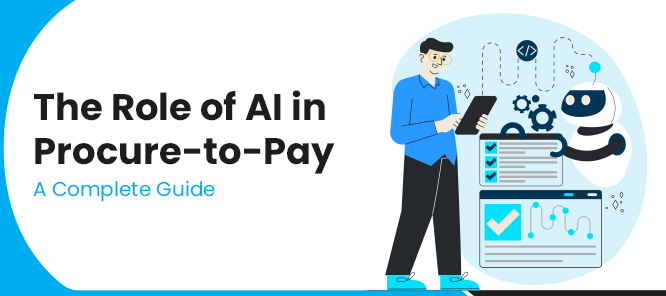
March 7, 2025
The Role of Artificial Intelligence in Procure-to-Pay (P2P)
Introduction
Imagine being the purchase head of a large organization, tasked with ensuring all essential goods and services are procured efficiently, within budget, and from reliable suppliers. Yet, every month, you face the same challenges — long processing times, errors in challan matching, supplier disputes, and endless paperwork. The repetitive cycle of manual approvals, compliance checks, and data entry feels never-ending.
Now, picture a system that can automate these processes, eliminate inefficiencies, and make intelligent decisions based on historical data. This is where Artificial Intelligence (AI) is making a game-changing impact in Procure-to-Pay (P2P) automation.
With AI-enabled P2P solutions, businesses can reduce procurement cycle times, improve supplier relationships, and prevent fraud, resulting in substantial cost savings. According to a Deloitte report, AI-managed procurement can reduce purchase costs by up to 30% and increase efficiency by more than 50%.
In this blog, we explore how AI is transforming P2P processes, its benefits for procurement leaders, and the future of AI-driven procurement automation.
Understanding the Procure-to-Pay (P2P) Process
Before exploring AI's role, let's understand the basic P2P process, which refers to the complete cycle of procuring goods or services and making payments to suppliers. The steps typically include:
- Purchase Requisition (PR) Creation: Employees request necessary products or services.
- Approval Workflow: The PR is reviewed and approved based on budgets and policies.
- Purchase Order (PO) Generation: A PO is created and sent to the supplier.
- Goods/Services Receipt: The organization receives and verifies the order.
- Invoice Matching & Approval: The supplier’s invoice is matched with the PO and goods receipt.
- Payment Processing: The approved invoice is processed for payment.
Traditionally, these operations were manual, leading to errors, delays, and inefficiencies. However, AI is revolutionizing this process by automating approvals, enhancing decision-making, and reducing risks.
How AI is Transforming Procure-to-Pay (P2P) Automation
AI goes beyond simple automation — it introduces intelligence to procurement operations, enabling predictive decision-making, fraud detection, and process optimization. Here’s how AI is reshaping the P2P landscape:
1. AI-Driven Procurement Analytics & Spend Optimization
- Real-Time Spend Analysis: AI tracks procurement expenses and suggests optimizations.
- Predictive Budgeting: AI forecasts future spending trends based on past data.
- AI-Based Supplier Selection: AI recommends the best suppliers based on pricing, quality, and past performance.
According to Gartner, AI-powered procurement analytics can help organizations save 20-25% on procurement costs.
2. Intelligent Purchase Requisition & Approval Workflows
- AI Auto-Fill Requisitions: Predicts frequently ordered items and auto-generates requisitions.
- Automated PO Approvals: AI speeds up approvals, reducing processing time by 50%.
- Smart Contract Management: AI scans contracts to identify compliance risks.
3. AI-Powered Invoice Processing & Fraud Prevention
- Automated Three-Way Matching: AI cross-checks invoices with POs and receipts for accuracy.
- AI-Based Fraud Detection: Identifies anomalies and flags suspicious transactions.
- Supplier Query Chatbots: AI-powered bots handle invoice status queries, reducing workload.
A Deloitte report reveals that AI in invoice automation can reduce processing costs by 70%.
4. AI for Supplier Relationship & Risk Management
- Risk Assessment: AI evaluates supplier risks based on financial health and past performance.
- Smart Vendor Selection: AI suggests alternative suppliers during disruptions.
- Predictive Risk Alerts: AI notifies procurement teams of potential supplier issues.
According to McKinsey, AI-driven supplier risk management can reduce supply chain disruptions by 40%.
Key Benefits of AI in P2P for Procurement Leaders
AI-powered procure-to-pay software offers numerous advantages:
Faster Procurement Cycles: AI eliminates bottlenecks and accelerates approvals.
Cost Reduction: Optimizes procurement spending through advanced analytics.
Improved Compliance & Accuracy: Ensures adherence to policies and regulatory standards.
Better Fraud Detection: Identifies suspicious transactions, reducing financial risks.
Enhanced Supplier Collaboration: Streamlines processes and strengthens vendor relationships.
Challenges of Implementing AI in Procure-to-Pay (P2P)
While AI offers significant benefits, there are challenges:
Integration with Legacy Systems: Many companies use outdated ERPs that are not AI-compatible.
Data Quality Issues: AI needs high-quality data for accurate decision-making.
Change Management: Employees may resist automation, fearing job loss.
High Initial Investment: Requires upfront investment in technology and training.
Future Trends in AI-Powered P2P Automation
The rapid progress of AI in procurement is leading to groundbreaking innovations:
Autonomous Procurement Bots: AI-driven bots will handle procurement decisions with minimal human input.
AI & Blockchain Integration: Ensures transparency and security in supplier contracts.
Voice-Activated Procurement Assistants: Enable hands-free procurement approvals.
According to Gartner's research, these trends will redefine the P2P landscape, making processes more efficient, intelligent, and uninterrupted.
Conclusion
AI is revolutionizing the procure-to-pay process, enabling businesses to achieve greater efficiency, cost savings, and fraud prevention. Procurement leaders who embrace AI gain a competitive edge through smart, data-driven decisions.
Final Thought: AI-powered procurement is not just the future — it is the present. Organizations that fail to adopt AI in P2P will struggle with inefficiencies, compliance risks, and missed cost-saving opportunities.
Interested in exploring how C1’s AI-driven P2P solutions can transform your procurement operationsContact us today!
Smart Solutions for Smart Procurement
Get in touch with C1 Global to get all the details on our best-in-class offerings or to schedule a demo.
0 Comments:
Leave a Reply